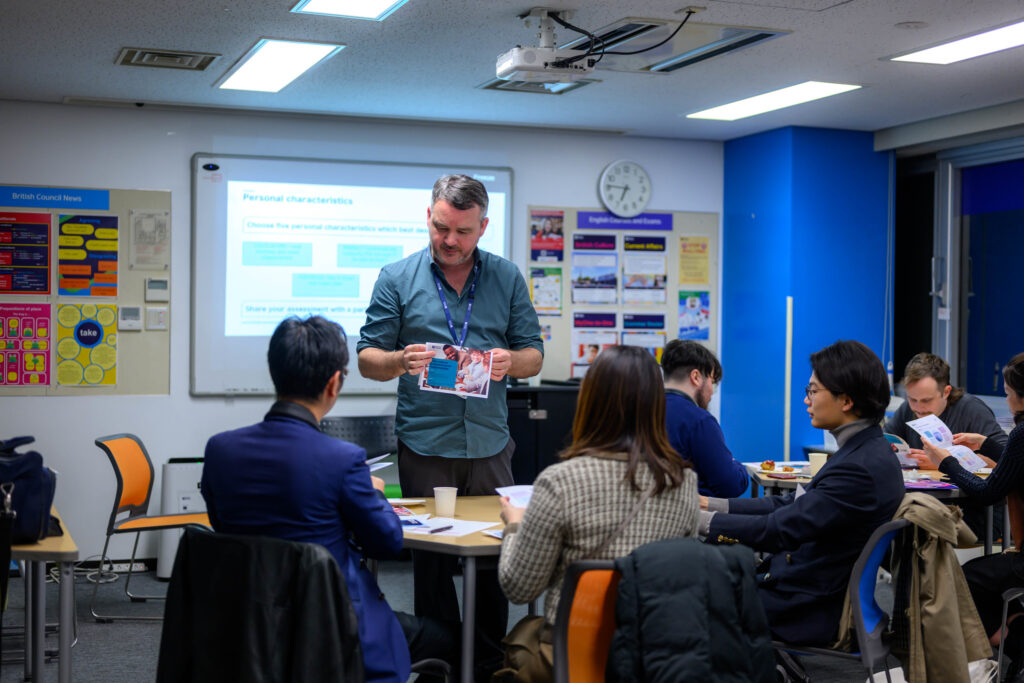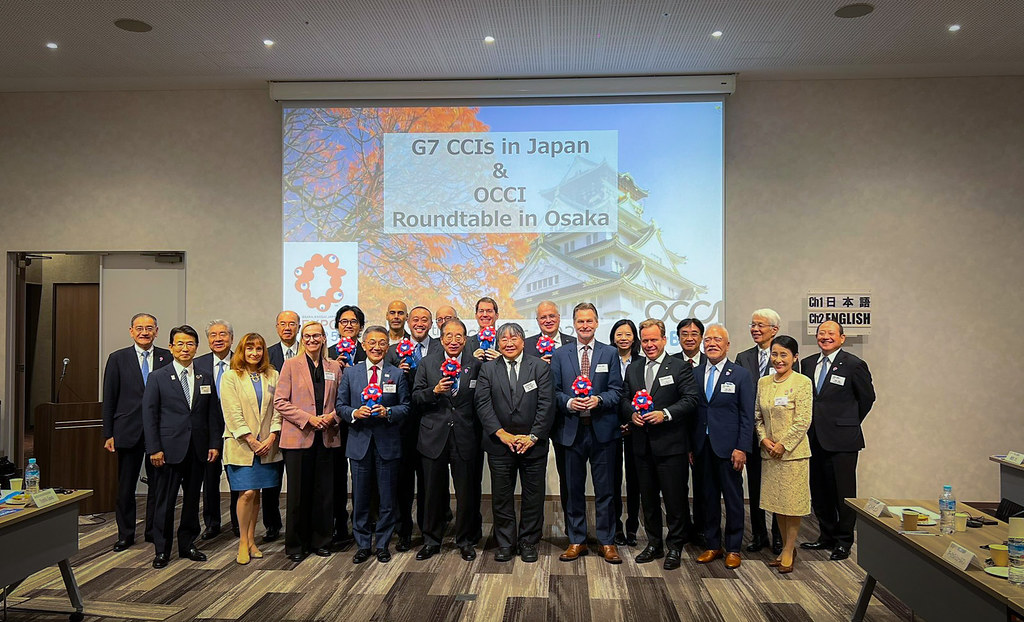Member? Please login
Remembering March 11

Golden Minamisanriku - Hiroshige Kagawa
Written by BCCJ
March 11, 2021
Community and Business
Introduction
Ten years have now passed since the earthquake. The terror of the initial shock on that Friday afternoon, the remorseless power of the tsunami, and the fear of the invisible as the nuclear plant seemed to verge on catastrophe – from a few minutes of the initial shock, to a period of horror at the extent of the tragedy, to the years now of reconstruction and repair, this is an anniversary of an event which still feels very recent.
The tragedy is a human one – lives lost, lives dislocated, communities broken and a region distressed. These are the pieces which cannot be replaced and where the pain is deepest. Buildings and towns and villages can, and have been, rebuilt and replaced but the human sadness will remain.
The tenth anniversary is a chance to remember what happened, to share the sadness, and to re-commit to the recovery of the people and communities of Tohoku.
To help us remember, the BCCJ invited a number of people from our community to share their memories. You will find pieces by Sir David Warren, UK Ambassador to Japan at the time, and Phil Gibb, then BCCJ President. We also are grateful to Caroline Pover, whose commitment to the region and its recovery is full of energy and humanity. Gavin Blair, Kenneth Cukier, Justin McCurry, Julian Ryall and Henry Tricks are all journalists who covered the disaster, and who in many cases were first on the scene. In such chaotic times, and in the shadow of the nuclear disaster, they showed considerable personal bravery in doing their jobs. Tatsuhiko Inamoto of Refinitiv tells us what it was like for a Japanese person posted overseas at that time with family in Fukushima.
We invite you today to remember March 11th 2011. We will later be looking at Tohoku today, and how the BCCJ and its members can continue to contribute, whether through charity, CSR, or meeting business needs.
Today, we remember.

Sir David Warren
The tenth anniversary of the Great Eastern Japan earthquake is a moment for reflection and memory. All of us who were in Japan at that time remember where we were that Friday afternoon. I was in Yokohama just about to call on Nissan to discuss future investment plans in the UK when the earthquake struck. It took me several minutes to figure out precisely what had happened and what I needed to do next, such was the shock – in all senses. By the time I got back to Tokyo – six hours later – we had all seen the horrific television pictures of the tsunami and the devastation that it had wrought, and the first reports of something having happened at the Fukushima Daiichi nuclear plant were coming in.
Over the next month, working with an Embassy and Rapid Deployment Response team of enormous commitment and dedication, we witnessed extraordinary examples of courage, endurance, community spirit, generosity and fortitude, both in the areas destroyed by the tsunami and more widely. For thousands of families in that region, that trauma did not disappear as the waters receded and the immediate threat abated. Despite the Government’s continued and active support for the rebuilding of those communities, investment in the areas affected, and the patient work to decontaminate the irradiated area around Fukushima, psychological damage and economic hardship remain. Many organisations, including many British volunteers and the British Chamber of Commerce, played, and continue to play, an important role in addressing these issues. Much has been done in ten years. But we should take this anniversary of a dreadful disaster – the worst to affect Japan since the Second World War – to remember those whose lives and livelihoods were destroyed, and continue to do what we can to help those who survived to rebuild their lives.
Sir David Warren was British ambassador to Japan from 2008 to 2012, having served twice before in the British embassy in Tokyo during his career with the Foreign and Commonwealth Office (FCO). He was also head of the FCO’s China Hong Kong department from 1998 to 2000, and a member of the FCO’s board of management (as director of human resources) from 2004 to 2007. He is a member of the council of the University of Kent, having served as chair from 2014-2020, was an Associate Fellow of the Royal Institute of International Affairs (Chatham House) until December 2020, and is an Honorary Professor at Sheffield University and a member of the Management Board of the Sainsbury Institute for Japanese Arts and Cultures at the University of East Anglia.
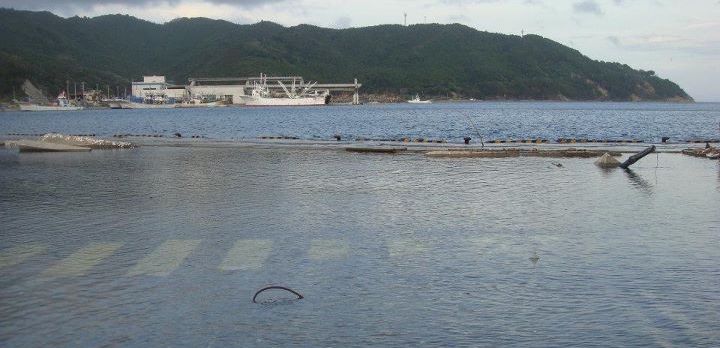
Peaceboat trip to Ishinomaki
***
Philip Gibb
“Are we moving?” asked one of my colleagues. It was 2:46 on the afternoon of 11th March 2011. A typical question in the life of foreigners living in Japan where earthquakes are common. Indeed, we were. What was unusual this time – continuing shaking – seconds morphed into minutes. This was different. The shaking continued on and off for many days to come courtesy of the many aftershocks.
The outlook from my 7th floor desk was across the roof tops of Azabujuban to my right and all the way up to Izumi Gardens to my left. The roof aerial opposite was whipping from side to side and more worryingly so was Izumi Gardens – a glass clad tower block above Roppongi-Itchome Metro station. Thank goodness for the flexible earthquake proof foundations, as a collapse of that building would be horrendous, I thought absent mindedly.
I phoned home to see if everything was OK and, of course, to check that my beloved TV had not crashed to the floor. I could not get through. That seemed odd. I tried my mobile but that too was not working – how strange?
Five of us working in the office were trying to make sense of what was happening, the shaking that normally subsides after 20 seconds or so kept on going in waves. Do we stay inside or do we leave the building? Looking out the window we could see the normally bustling streets were now packed with office workers looking bewildered as the shaking continued – what should we do, where should we go?
The lift in our building had stopped working courtesy of the earthquake override system kicking in, so we headed for the fire escape only to find everyone else in the building doing exactly the same thing. Wasn’t it more dangerous being out on the street from falling glass? No matter, the sheep mentality was a strong influence on all of our actions.
On reaching street level it was chaotic, normally quiet streets were busy and noisy – something unheard of in sedate, private Japan, where hushed conversations are the norm, especially in public spaces.
Amashiro Park was two streets away and this seemed like the best destination for us to head towards – open space among the high rise residential and office buildings, so no danger of falling glass or masonry.
Unsurprisingly, we were not alone. The square filled quickly, mainly foreigners, as it is a gaijin friendly office and residential district. The ground continued to shake, lamp posts quivering like jellies and now it was at least 15 minutes after the first tremor – this really was not normal. Lots of people were busy studying their mobile phones trying to get them to connect to any network. Then a shout went up that Facebook was actually working and that messages were beginning to get through.
Bizarrely, on one corner of the square there was a building site with Japanese scaffolding workers continuing to go about their business even though the metal skeleton structure was swaying with each successive tremor, rolling rhythmically every few minutes.
Then, an image that will remain with me. A smartly dressed Japanese salary man replete with brief case walked up to the drinking water fountain at the edge of the children’s play area. He started searching in his brief case and then with a smile on his face took out a tooth brush and toothpaste and proceeded to clean his teeth thoroughly for the next ten minutes. Stopping occasionally, refreshing his brush in the running water. Surely, they were the cleanest teeth given the energy he expended in his dental routine. His expression was stoic, determined even – no matter the ground was shaking and completely oblivious to the incredulous onlookers trying to work out his motivation. Why, during an extended series of earthquakes and inevitable aftershocks, would you think that a public display of dental hygiene be a conduit for a coping strategy?
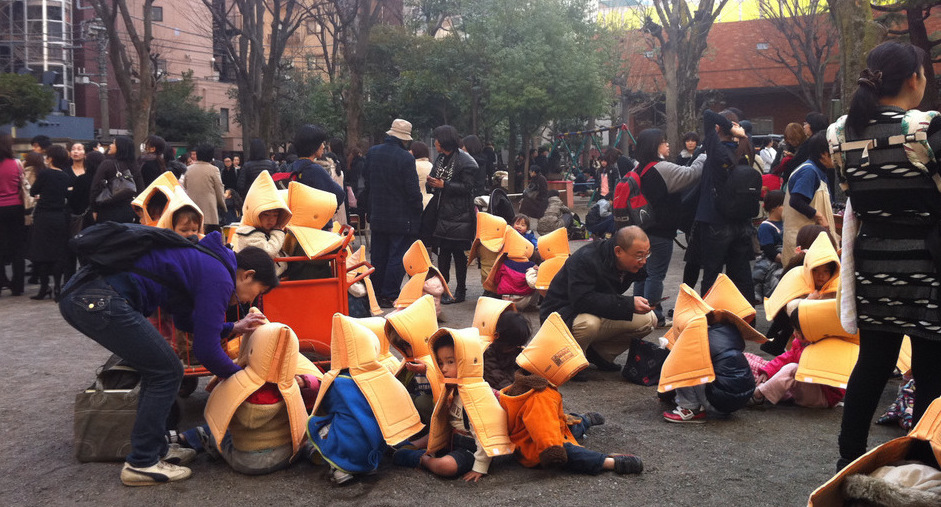
Refocussed role for BCCJ
It’s always interesting to take a step back. Especially when things are unexpected. How do you react to a given situation or better still how should I have reacted with the benefit of hindsight?
The Presidency of the BCCJ is somewhat of a voluntary figurehead role. Having said that, I took my responsibilities seriously. My immediate thoughts were to get through to the Chamber office to make sure the staff were all safe. The office was still in the British Council building in Iidabashi. Ian de Stains, the then Executive Director, had recently returned to work after a triple by-pass heart operation to start the hand over process to our new Executive Director, Lori Henderson. Samata-san the stalwart Office Manager was, as ever at her desk or should I say, under it as is the training all Japanese have from birth whenever an earthquake is experienced.
Having made sure all was as well as could be expected, I asked that we start a telephone tree among the Excom committee members to check everyone was safe and offer-assistance if needed, including contacting the British Embassy.
We got through to most people in the hours that followed, two notable exceptions – Russell Anderson, Head of Jaguar LandRover Japan, was stuck on a highway from Tochigi and the British Ambassador, David Warren, as he was then, was stuck on a highway between Yokohama and Tokyo both incommunicado until much later in the evening. Neither of them could be contacted as a result of the mobile network being unavailable.
12th March was another day – a day of realisation, a day of rebuilding, a day of starting the process of restoring normality albeit amidst the continuing aftershocks. Telephone lines had started to work again. I spoke with my Vice President and the Chamber office and the British Embassy to begin the process of putting in place plans to disseminate information to the business and wider expatriate community. The information on the impact of the nuclear fallout was coming directly from the UK’s Chief Scientific Advisor, Sir John Beddington and his team.
The devastation in Tohoku was beamed worldwide – shocking images of communities lost, people missing and who could forget the threat posed by the multiple nuclear meltdowns in Fukushima.
Many Chambers of Commerce as well as some Embassies in Tokyo had either left Japan or moved to Osaka such was the confusion and messaging from the Japanese authorities and media.
The work of the Chamber changed from being a source of business advice and guidance between British and Japanese companies to a support organisation disseminating accurate information on what was really going on in the aftermath of the earthquake, tsunami and nuclear meltdowns. It was ironic that even the Japanese Government began referring to the British Embassy & Chamber communications strategy and what was happening at Fukushima.
Three weeks after the earthquake it was decided that he BCCJ host a lunch for the international community at the Conrad Hotel to provide an update. The lunch featured the UK’s cool-headed Chief Scientific Adviser, Sir John Beddington. Such was his draw, that a Japanese Government representative joined us to see what he had to say. Sir John spent some additional time with both Embassy officials and Japanese Government departments during his visit to Japan.
Volunteering
Volunteerism, something uncommon in Japan before 2011 began its putative stages as a result of the triple disasters. Companies and individuals wanted to help but how, where, when and most importantly what could be done?

Various disaster relief groups, some international, descended on Tohoku. One team arrived by helicopter and landed just outside the limit of the tsunami ravaged coastline, adjacent to a 7-11 convenience store. Unsure what they could take with them as immediate disaster relief, they chose several boxes of oranges. Imagine their surprise when walking into the store, the first thing they saw was oranges for sale!
One of the first things the Chamber did was to arrange a fundraising evening at the ANA InterContinental Hotel courtesy of Fergus Stewart, General Manager of the Hotel. The Chamber team and Excom pooled resources to obtain prizes from member companies for a charity fundraiser to raise disaster relief cash.
It was a memorable evening for several reasons. Record amounts of prizes donated, money raised as well as providing the comfort of everyone being able to share their experiences of 3/11 – a healing process in its own right. Then at 11:25pm everyone’s mobile phone alarms went off as another aftershock hit. This one was a 7 on the Richter scale. The 36th floor venue meant that the Hotel rocking foundation system allowed an extended time of rocking after the quake had stopped. An unwelcome déjà vu moment.
Tohoku
Several weeks later, along with Lori Henderson our new Executive Director, I joined a weekend volunteer work party in Tohoku close to Onagawa.
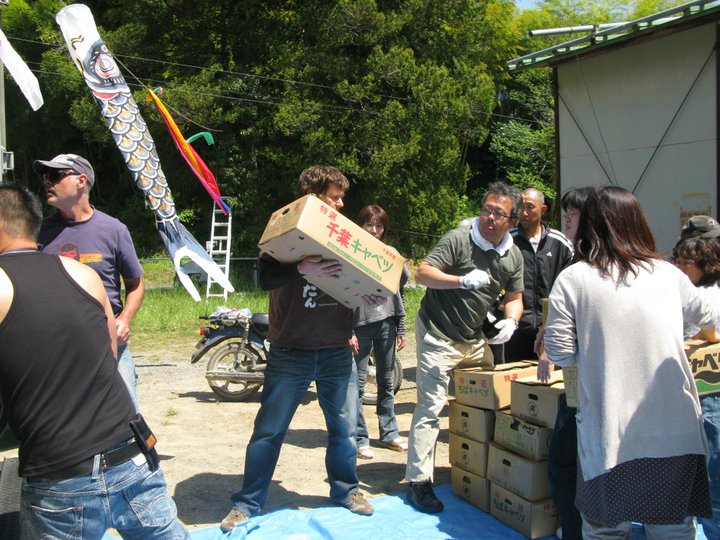
We left Shinjuku at 11pm on a Friday evening to travel by overnight bus to Tohoku. Sleeping on an overnight bus is not the most comfortable experience and breakfast on arrival was courtesy of whatever you could find in a local Tohoku convenience store.
We could not stay in Onagawa as it was literally swamped. Not only did the tidal wave engulf the narrow inlet the city was built on, the neighbouring mountain valley was engulfed from behind such was the height of the wave. I had never seen a six-storey building flipped on its side before – total devastation.
The impact of the earthquake meant that Onagawa is now twelve metres closer to the west coast of the USA and now one metre lower resulting in the tide entering the city twice a day. Truly an earth moving experience.
We assembled at what was our overnight accommodation, a school hall. No beds, no air conditioning other than open windows, no seating other than the floor. We dropped our bags and were asked to line up outside to collect spades, wellington boots and wheelbarrows.
Before we could do anything of course, we were lined up for the 8am Japanese morning exercise routine via Raijio Taiso. We all needed to be in shape for the tasks ahead. Volunteer or not, some things remain in Japan and no amount of post disaster recovery efforts would mean missing out the perfect start to the day.
We were then directed to where we would be working that day. Our work party task was to clean a family cemetery that had been damaged in the aftermath of the tsunami. The task was relatively simple – shovel sand into bags. Sand that had been hitherto on the seabed several kilometres away so the smell was not one that you would willingly expose yourself to. The aroma was tainted with the general smell of decay augmented by the fact that the temperature was now 38C and it was only 9am. It was warm, very warm, the work hard but the sense of achievement that the multinational group of volunteers gained more than made up when the older members whose family graves we had cleaned, thanked us for our work with tears in their eyes. They could not really understand why these gaijin would do something like this even though they were very grateful.
Dinner was supplied by other volunteers. Rice, umeboshi and onigiri. So, all we had to do now was get some rest. There was literally nothing else to do. Sleeping on the floor of a school after a long shift in the baking sun, no shower (copious amounts of wet wipes courtesy of Unilever) had one real upside, everyone was so knackered that any snoring literally fell on deaf ears.
The journey back to Tokyo was long and silent. The seven buses all travelled at 50mph in line order, no overtaking. At each service station stop, every two hours, the busses lined up in order and left in order. Passengers making use of the comfort breaks. Silence on board, each volunteer lost in their own thoughts. What had they done? What more could they do? How could this happen? Where and when can they shower? Indelible images tattooed in their minds as a reminder of the real power of mother nature.
Bell of Hope
Four years after the disaster – March 2015, Prince William visited Japan to see for himself the recovery efforts in and around Onagawa. I had the privilege of attending the events and to see him ring the Bell of Hope in a shopping village that the BCCJ was instrumental in helping. Our aim as a Chamber of Commerce was to support groups and individuals who were rebuilding their commercial businesses in the devastated areas. The bell he rang was found among the rubble so a fitting symbol and tribute to all the people who helped make this happen.
Philip T Gibb OBE was BCCJ President 2010 – 2012
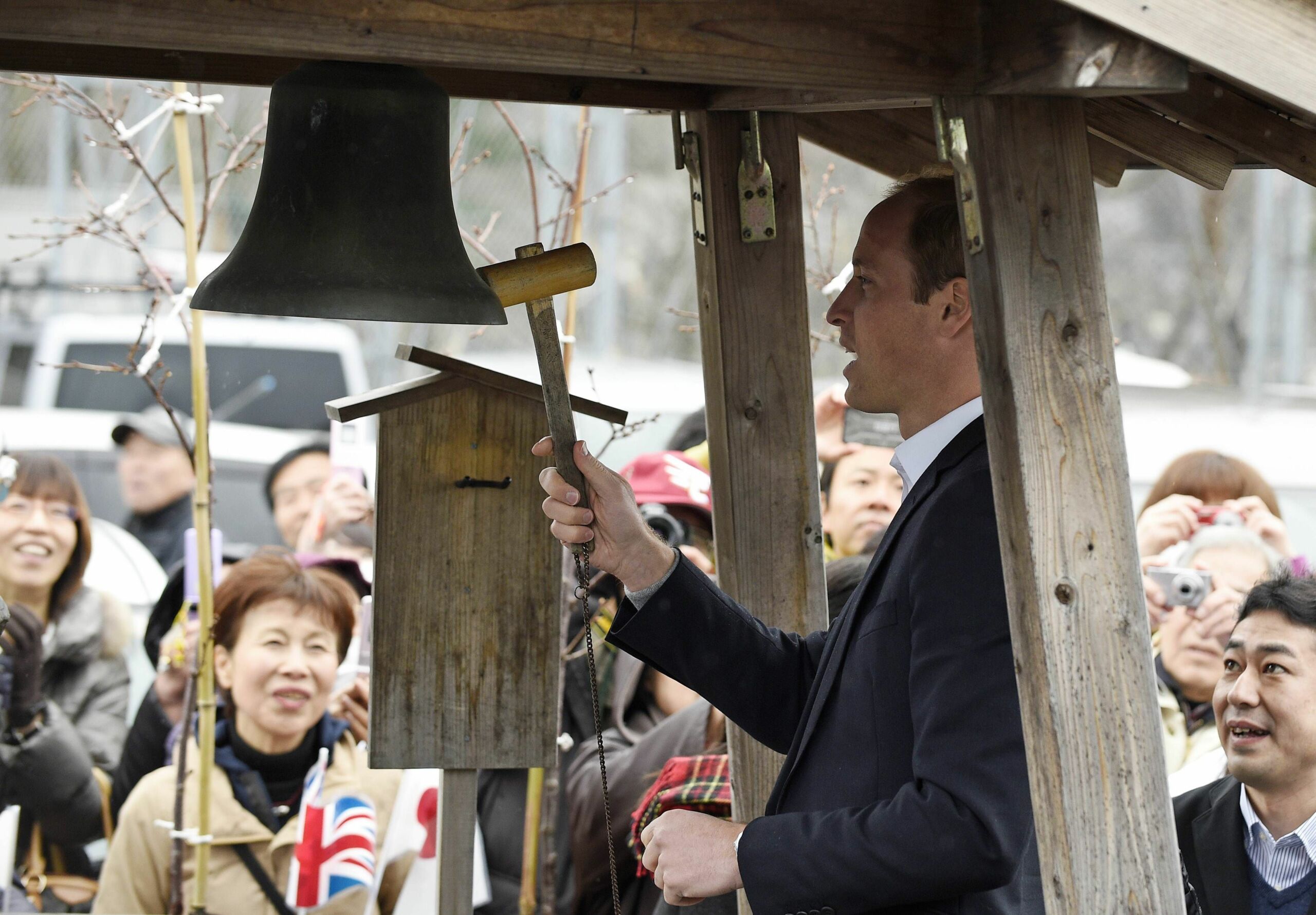
***
Caroline Pover
March 11th is a day that none of us with a connection to Japan will ever forget. But now, when I am asked about that day, I don’t think about that one day. I think about the entire decade that has passed since.
I think about the little children in a North Devon village that held a sponsored sleepover, and about how teenagers went on a sponsored hike in a Cotswold town. I think about the generosity of a huge network of friends and associates in the UK and in other countries, who together contributed £170,000 to support projects for these little fishing communities in a place they had never heard of before — projects to support people that in the past decade I have become so fond of; people who have embraced me as one of their own. I think about the kindness that has flourished between the people of Tohoku, and those that offered support. And I have been inspired to see my friends on Oshika as they found — and continue to find — love and laughter through disaster.
Time and time again, during the past decade, they have proved to me that trauma, resilience, and hope, are things we can all learn to live with and learn from, if we keep our hearts open.
Caroline Pover is author of “One Month in Tohoku: An Englishwoman’s memoir on life after the Japanese tsunami.”
***
Gavin Blair
It was two small, somewhat insignificant acts of kindness and consideration in the aftermath of 3. 11 that stayed with me, drove home the resilience of Tohoku folk, and brought tears to my eyes. I was at an evacuation centre along the coast from the Onagawa Nuclear Power Plant, not far from Ishinomaki, with two other British journalists, Rob Gilhooly and Julian Ryall. The local community had been obliterated. The remnants of their lives were scattered over the coastline of the peninsula: photographs, clothes, sports trophies, pieces of houses and cars.
Inside the centre, evacuees told us how well we’d done to make it up from Tokyo; I didn’t know how to respond. Then they offered us tea and snacks. It was the first week after the disaster and supplies weren’t arriving regularly. We declined as politely as possible. After the interviews were over we went to leave and someone had lined our shoes up neatly facing the door. Another little piece of thoughtfulness that was way beyond what I could imagine doing for strangers in such circumstances.
The three of us recently returned to Tohoku to report for 10th-anniversary features. Most of the towns and cities were unrecognisable, though wide empty lots near the ocean remain as evidence of the devastation. People were again friendly and welcoming, even those in Minamisanriku and at Ookawa Elementary School in Ishinomaki who had lost children, a pain I can’t and don’t want to imagine.
If there was anything positive I took from reporting on the disaster a decade ago, it was to be appreciative of the people around you and the life you have. It was a feeling that had inevitably faded in the intervening years, but that being on that battered coastline had reminded me of, at least for now.
Gavin Blair covers Japanese business, society and culture for publications in the U.S., Asia and Europe and is the author of Zen in Japanese Culture: A Visual Journey through Art, Design, and Life.
***
Kenneth Cukier
The second-story of the coffee shop in Tokyo started shaking, jerking and swaying wavily. People started to rush out. I rushed out too — but first collected my trash and hastily sorted my paper cup and plastic lid into different recycling bins. Such is Japan: even amid a crisis, one defaults to the norm. That night, a miles-long line of commuters walked home — yet no one crossed against the red lights at intersections, even though cars were at a standstill. Again, a crisis couldn’t shift Japan.
The images of the tsunami were horrific: the cars crushed under waves away and burning homes washed out to see. The Fukushima disaster was atrocious because it was entirely man-made, from an archaic reactor, to a backup generator situated near the coastline, to a dithering establishment that delayed pouring seawater to cool it — to say nothing of building it on a fault line. Within a few days, I traveled to the disaster zone to report on the carnage and was inspired by the spirit of the survivors.
I believed the calamity would break the pathologies of postwar Japan, from the system of amakudari that let energy companies escape regulations, to the press-club system that let officials avoid serious media scrutiny, to the failure of corporate boards to have independent directors and thus rigorous oversight. It was all interconnected, and the system of “Old Japan” was strangling the country’s rebirth. Surely the crisis would be the catalyst for reform?
Yet it was not meant to be. Honourable government officials who spoke out against problems were shunted aside. Whistleblowers faced repercussions. Reform-minded officials and businessmen stayed quiet. Independent reviews of Fukushima were published but there were barely any sanctions. The country changed a little, yes — but not too much. Even a catastrophe couldn’t shift it, just as the line of commuters walking home couldn’t cross against the light, and I felt the need to sort my trash before running out of a shaking building.
Perhaps this is the curse of Japan, as well as its greatest feature. The country prizes tradition, though sometimes it reveres that which poisons it. Can one maintain its reverence for norms while abandoning the long-standing features of society that seem to hold it back? Can any of us?
As an optimist, I believe the country can certainly retrain the positive aspects of its political economy while discarding the practices that don’t fit modern times — the conflicts of interest, the protected monopolies, the lack of regulatory oversight. But I was proved wrong a decade ago. It is up to the country, ten years on, to use the anniversary to ask itself hard questions and act on its answers.
Kenneth Cukier is a Senior Editor at The Economist, and was the paper’s Japan business correspondent from 2007-12. His latest book, “Framers: Human Advantage in an Age of Technology and Turmoil,” is being published by Penguin in May.
***
Justin McCurry
I was working in Osaka on March 11, 2011. Even there, hundreds of miles from the epicentre, the earthquake was powerful enough to prompt me and other people in the neighbourhood to leave our homes for the safety of the street. After filing multiple quick takes on the tragedy unfolding in Tohoku, I returned to Tokyo the following morning to coordinate the Guardian’s coverage of the tsunami aftermath with colleagues who had flown in from China and the US. It wasn’t long before news began to emerge that something serious was happening at the Fukushima Daiichi nuclear power plant. In the days that followed, I cycled to afternoon press briefings at Tepco’s headquarters Shimbashi, returning home to combine what I had learned about the meltdown – although Japanese media had yet to use that term to describe the crisis – with on-the-spot reports from the coasts of Miyagi and Iwate prefectures.
I made my first trip to Tohoku towards the end of March, along with a videographer and photographer. Starting in Miyako in the far north, we made stops in Kamaishi, Kesennuma, Rikuzentakata and Sendai. We spoke to survivors – many of whom were grieving the loss of relatives and friends – and surveyed the damage, before ending our road trip in a near-deserted Minamisoma in Fukushima prefecture.
That was the first of countless trips I have made to the region in the past decade, including half a dozen visits to Fukushima Daiichi. The 10th anniversary was a moment to take stock of the recovery effort in Tohoku, and remember the many people who have gone out of their way to help me report on what for many Tokyo-based correspondents was the biggest story we will ever cover. Ten years on, I am still in awe of the strength and determination shown by the people I’ve met – from fishermen and farmers to business owners and medical workers. Yet even those admirable qualities pale beside the generosity of spirit that kept the people of Tohoku going in unimaginably tragic circumstances, and which will serve them and their region well into the future.
Justin McCurry is the Japan and Korea correspondent for the Guardian and Observer. His book about keirin cycling, War On Wheels, will be published in the US and UK in June.
***
Julian Ryall
The last decade has simply flown by.
On the afternoon of March 11, 2011, I was on a train that came to a shuddering emergency stop under a visibly shaking elevated highway in west Tokyo. The next couple of weeks are something of a blur punctuated by images that are far harder to erase from my memory, of body bags in school gymnasiums serving as makeshift morgues, the thousand-yard-stares of deeply traumatised survivors, of homes reduced to rubble and splintered wood and neighbourhoods simply swept away in their entireties.
It was shocking for a reporter asked to turn the survivors’ experiences into stories; it was by several magnitudes more awful for those who had lived through it. And always, at the back of my mind, was the thought that I could always turn around and go home. And then guilt, as the people I was speaking with had no such luxury.
I returned numerous times over the next three or four years, but the news cycle moved on to new disasters. The 10-year anniversary of the earthquake and tsunami has offered, however, a chance to go back and to once again speak to people in Ishinomaki and Minamisanriku, just two of the towns that made the headlines in 2011.
The debris – the upturned cars and canted fishing boats that were so photogenic back then – has long gone and modern apartment blocks have replaced the traditional wooden homes that were still a frequent sight before the disaster. Light industry has returned to the waterside areas, shops and restaurants have rebuilt and reopened and massive sea walls have replaced their puny predecessors, at the cost in many places of a view of the ocean and estuary.
And while the local people I spoke to were putting a brave face on it, a decade is not nearly enough time. It’s all still too raw. These are ordinary people who lived through an extraordinary time and lost friends and family to the disaster, along with their homes, businesses and ways of life.
I doubt many editors will be interested in a return to Tohoku on the 20th anniversary of the disaster, but if they do I fear there will be many residents whose present is still too firmly tethered to the past.
Julian Ryall is Japan correspondent for The Daily Telegraph.
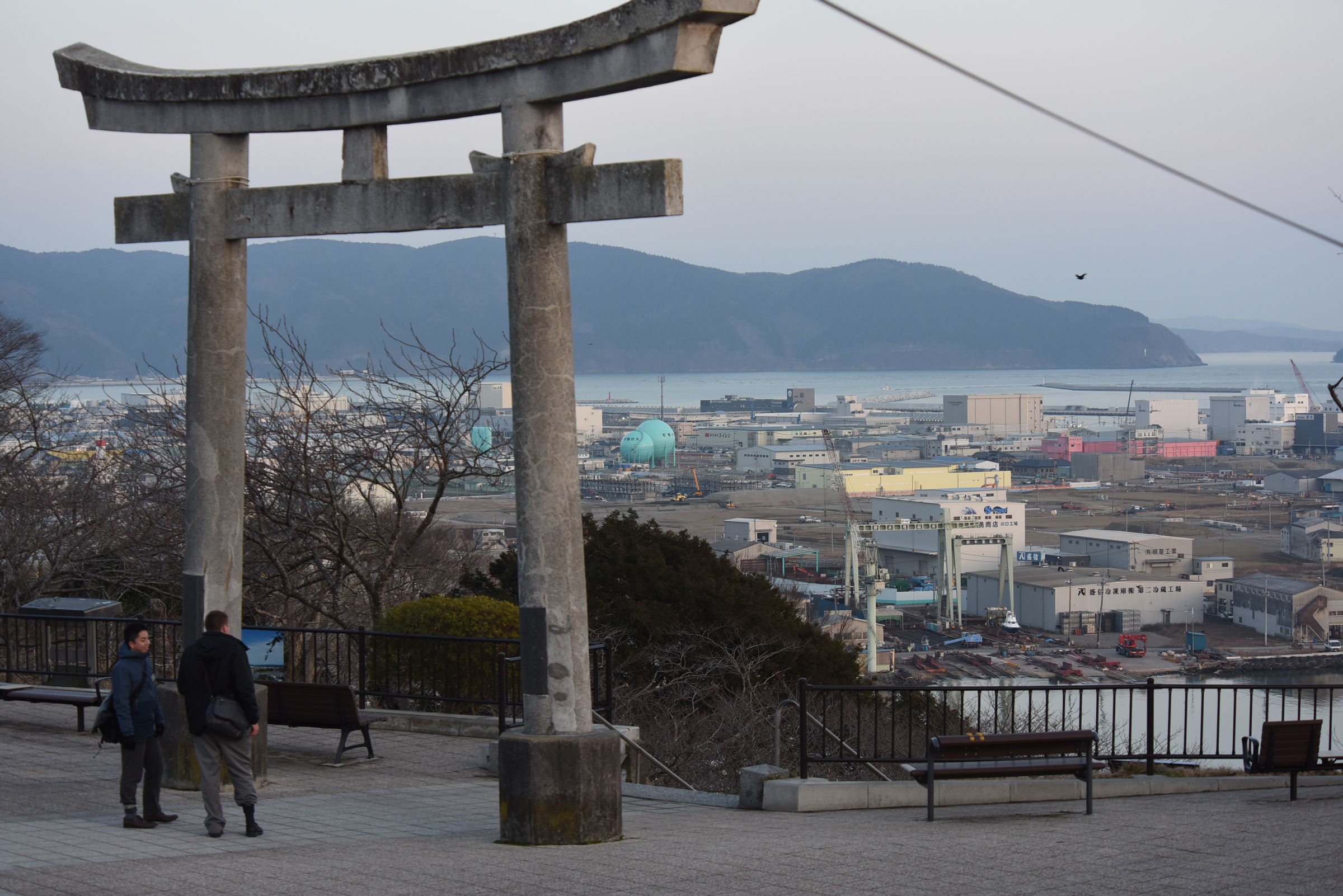
***
Henry Tricks
When the earthquake struck, I was having a late lunch in a small wooden izakaya near Omote Sando. The shock of pots falling off walls, the narrow road outside buckling and the overhead power lines clanking dangerously together was one thing. The way people clung to each other – and then, when the worst of the shock passed, lined up patiently to pay for their lunches was another. So many people displayed dignity and grace in that moment, it was no wonder the world looked on in admiration at the strong bonds at the heart of Japanese society. But that awe turned to shock and horror later in the day when footage of the tsunami engulfing towns and swallowing up people and cars was aired on television, and the first gnawing anxiety emerged about the Fukushima Dai-ichi nuclear power plant. An image haunted me. That of the city of Kesennuma in Miyagi prefecture, where the tsunami had not only destroyed the fishing port but led to the ignition of oil storage tanks that turned the night sky into a Dante-esque inferno.
Some days later I managed to reach Kesennuma and walked through the blackened, waterlogged remains of the port. A nurse told me how she had shepherded patients in a nearby psychiatric hospital onto the roof after the tsunami, and they had watched the city burn. About how a young hairdresser had turned up a few days later offering to cut the patients hair as a gesture of kindness. I saw a string of pearls in the black mud. I saw people sifting through the wreckage of their houses, trying to rescue photographs and any other mementoes of their past lives. Yet there was defiance as well as despair when people discussed the awesome task of rebuilding. “Just you come back in ten years’ time,” one told me.
Henry Tricks writes the Schumpeter column on global business for The Economist and is based in London. Previously, he was the Energy and Commodities editor from 2015 to 2018. He joined The Economist as capital-markets editor in January 2006, and became finance editor later that year. He was Tokyo bureau chief from August 2009 until April 2013, and bureau chief for Mexico and Central America from 2013 to 2015.
***
Tatsuhiko Inamoto
It is my honour to be given this opportunity to write this article to the BCCJ for the commemoration of the 11th of March, 311 “san ichi ichi”.
I was born in Hiroshima as a third generation of atomic bomb survivors, lived in London and went to local high school for 2 years, joined REUTERS and looked after the infrastructure delivering the news and financial data in the region. March 11th 2011 was a month before my 4 years secondment in Singapore ended.
Whilst the solid IT infrastructure remained safe and continued to deliver the news and media, I was not able to reach my family, friends and colleagues in my home country for days and what’s been reported and broadcasted was only covering a part of what was happening. To this day it is hard to believe what happened – it was a scene from a disaster movie as the tsunami waves which reached up to 40 meters high hit the east coast, taking so many thousands of people’s lives. I, we, watched the footage of the tsunami, as it led to the meltdown of the nuclear plant in Fukushima, an incident on the same scale as Chernobyl in 1986.
My wife’s uncle was, and is still, running a business in Fukushima for 3 generations long, and is a member of the Fukushima Chamber of Commerce & Industry, and I have had a chance to talk to him on some occasions in the last 10 years. As time passed by, now even 10 years, normal life seems to have resumed, at least on the surface. But in reality, there’s no end to the recovery as he continues to challenge the harmful rumours which continue to exist for people and industry in Fukushima. We still cannot take full control back of the nuclear plants and shut them down. And there are people who continue to suffer from traumas and are still unable to even go back to their homes. Their wounds will never heal.
My daughter was born in 2011 and she will be 10 years old this year. We are currently in the midst of worldwide Covid-19 pandemic crisis. We all can continue to make our footsteps forward to pursue sustainable growth for what each of us are responsible for today by remembering and handing down what we experienced, witnessed, and learned.
Tatsuhiko Inamoto, Director, Service Management, Refinitiv Japan

***
Kathryn Wortley
When 3/11 happened, I was an assistant language teacher in rural Kagoshima. On hearing from a friend in Ibaraki about the frightening aftershocks and loss of utilities he was experiencing, my husband Chris and I invited him to stay with us along with anyone he knew who needed a place to stay. Soon, we were hosting eight people. Hearing their stories brought home the devastation and how it might impact people for years to come.
Fast-forward five years and I was living in Tokyo, back in journalism. In the lead up to the Rugby World Cup 2019, I attended a press trip to Kamaishi, where some 1,300 souls were lost and three schools were inundated. We saw where the tsunami had reached and heard heart-breaking reports from people whose lives had been upended in mere minutes.
The remarkable thing was that they all shared an unshakeable hope for the future. They rallied to host the Rugby World Cup, believing it to be a vital step on the path to long-term recovery. It was also an opportunity, they said, to feel pride in their town again and engage with the world. Their tenacity and positivity knew no bounds, even in the face of what seemed like insurmountable challenges.
It is this resilience that I believe continues to power recovery on the ground. On the 10th anniversary of 3/11, I am reminded of how far Tohoku has come in its reconstruction and of what still needs to be done. The local people are evidence that anything is possible in Tohoku’s bright future.
Kathryn Wortley is a Tokyo-based freelance journalist and travel writer, covering Japan for publications in the Asia-Pacific and Europe. She is also co-founder of content creation and editorial services provider, Sterling Content.

Keisuke Yamaguchi – Middle Scenery


